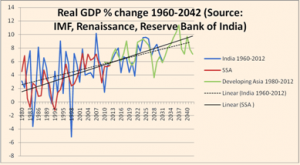Africa: following Asia’s footsteps
What is most surprising about Africa’s boom? Probably not the six-fold surge in oil revenues, which will rise to $300bn annually (three times Africa’s estimated annual infrastructure needs) by the end of this decade – most recognise China’s impact on African commodity exports. Nor the services sector growth, which despite the commodity headlines in fact accounts for over half of the GDP gains since 2002, three times more than the mining and mineral sector.
Many do know that Kenya leads the world in mobile banking and that half a billion sim card sales in seven years have created a communications revolution across Africa. It does still surprise a few that in sub-Saharan Africa 5-6 per cent annual growth is happening at all, after 20 miserable years of 2 per cent average growth from 1980-2000, and that Africa sailed through the western financial crisis as if the decline of the west was of minor irrelevance to Africa’s rise. It is a quiet but interesting reversal of the late twentieth century, when Africa was a minor irrelevance to the west.
But what surprised us most is the uncanny similarity of the African boom since 2000 to that of India since 1980 and of developing Asia since 1970.
In each case the boom has begun at a time of pessimism about the continent’s (or sub-continent’s) progress. In 1970, Asia was a continent riven by war and endemic corruption and China, the potential giant, was crippled by the ideological catastrophe of the cultural revolution. But it was during the early 1970s, as global inflation erupted and when the US was withdrawing from the quagmire of Vietnam, that developing Asia began to boom.
Fast forward ten years and India seemed to prove that democracy could only produce “Hindu” growth rates of 2 per cent over 1960-1980. It was during the second oil crisis, when US unemployment topped 10 per cent, that India began to record 5 to 6 per cent growth rates. Meanwhile, Africa’s boom began as the US tech bubble deflated.
While economists still debate what triggered India’s boom a full decade before the Singh reforms of 1991, we can point to some key factors driving Africa’s outperformance.
First, Africa’s leaders learnt very painful lessons from the lost 20 years of 1980-2000. Keep public finances under good control. This won 24 African countries debt relief, at a total cost of $74bn: smaller than Greece’s PSI and benefiting far more people. Public debt ratios halved to 32 per cent of GDP, even as western debt levels soared. The west will hopefully learn the same hard lessons now.
Second, the demographic surge has helped. Africa is the only continent experiencing a big rise in the 15-24 year-old age group. China’s 15-24 year-old demographic is dropping by 20-30 per cent his decade, and by between 47m and 67m depending on the source, enough to mean Asia’s overall young labour source is shrinking.
Thirdly and crucially, this demographic is better educated than any previous African generation. In the 1970s, just 13 per cent attended secondary school. Now the figure is probably over 40 per cent, similar to Turkey, Mexico and India when they emerged on the world stage.
Fourth, with growth has come the inevitable push for better leadership and more responsive government. While most countries could be classified as autocracies in 1990, now most (around 30) are democracies.
Fifth, a reform drive is under way. In 2010, for the first time, an African country, Rwanda, took first place in the World Bank Doing Business reform rankings.
What happens next should not surprise us. If sub-Saharan Africa has tracked India for 30 years, we can comfortably assume that it will do so for another 20 years, echoing India’s stellar performance since 1990, and follow Developing Asia beyond that.
Does this mean all Africa’s infrastructure problems will be addressed? Not at all. India’s power cuts show that however much is invested in infrastructure, it will be tough to keep up with booming demand. But we can expect annual growth to accelerate to 7 per cent in the 2020s and faster still in the decades beyond.
From 100m flights a year across the continent, we will see 400m by 2030 and 1.7bn by 2050. Nigeria’s steel output should rise from 1.6m tonnes a year now to 100m tonnes by 2050. The Geely or Tata of the 2020s may be east African. The stunning improvements in HIV infection rates, or in the number of deaths from malaria, both down 27 per cent from their peaks, and child mortality rates down by a third across 20 countries in just five years, will intensify as growth delivers taxes to spend more on health and education.
Democracy will spread as wealth rises, and corruption levels, which are already often better than per capita GDP levels imply, will fall. In this regard Africa will be no different from Europe, the US, Latin America and now Asia.
What may be the final surprise from the fastest billion? That our forecast for Africa’s GDP to increase from $2tn today to $29tn in today’s money by 2050, may be too cautious.
Charles Robertson is global chief economist at the emerging markets investment bank, Renaissance Capital, and author of The Fastest Billion.









